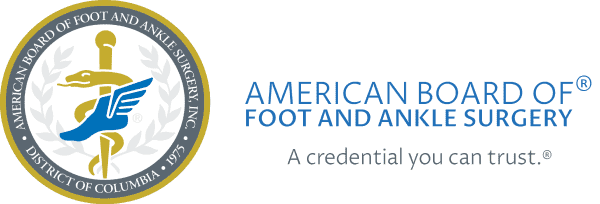Pathway to Certification
Note: It is important for patients, providers and the podiatric community to understand the differences between ABFAS Board Certification and ABPM’s unrecognized CAQ in podiatric surgery. The two are not comparable credentials. Learn more now.

From Board Certified Candidates to Diplomates: Detailed Pathway to Certification
Graduate from a CPME accredited 4-year podiatric college
Focus on gaining a high GPA
Consider extra-curricular activities
Research residency programs to find the best fit for you
Complete a CPME accredited 3-year minimum residency program
Practice with the ABFAS In-training Examination (ITE). Candidates will be able to use their passing ITE score for qualification purposes upon payment of a qualification fee.
Log cases in PRR and meet MAV diversity requirements
Successful Completion of Part I Board Qualification Examinations
- Foot Surgery Didactic
- NEW Foot Surgery CBPS
- RRA Surgery Didactic (if pursuing)
- NEW RRA Surgery CBPS (if pursuing)
Submit the following to ABFAS:
- Residency Completion Certificate
- Active, unrestricted, state podiatric medical license
- Proof of surgical hospital privileges
Once Qualified, pay the ABFAS Annual Fee
Candidates should log all cases in PLS for which they are the surgeon of record, post-residency until the passing of Case Review.
Successfully Complete Board Certification Examinations
- Foot Surgery Case Review
- RRA Surgery Case Review (if pursuing)
As of September 2020, candidates will need to pass the NEW CBPS exam if they have not yet already passed the old Part II CBPS examination.
Submit the following to ABFAS:
- Active, unrestricted, state podiatric medical license
- Proof of surgical hospital privileges
Once Certified, pay the ABFAS Annual Fee
Candidates should log all cases in PLS for which they are the surgeon of record, post-residency until the passing of Case Review.
Complete the LEAD program requirements during each ten-year cycle.
- Participate in LEAD.
- Meet the MDT p-value standard.
- Obtain 100 CMEs each five-year period.
- Be surgically active.
- Submit proof of surgical hospital privileges.
- Pay the ABFAS annual fee.
- Participate in LEAD.
- Obtain 100 CMEs each five-year period.
- Submit proof of surgical hospital privileges.
- Pay the ABFAS annual fee.
Time-limited Certification Requirements:
Lifetime Certification Requirements:
